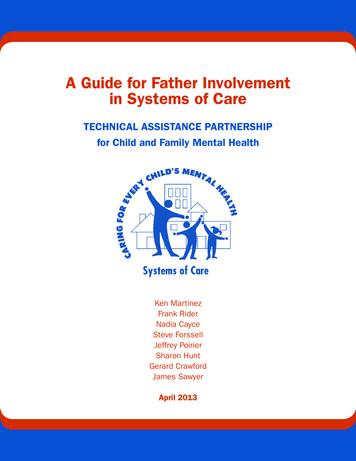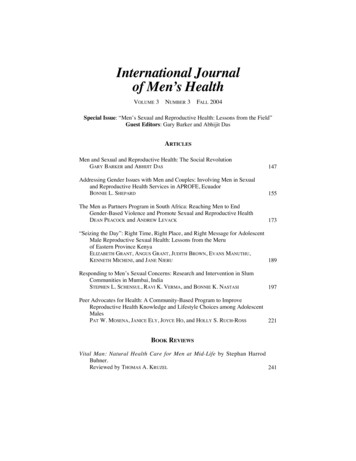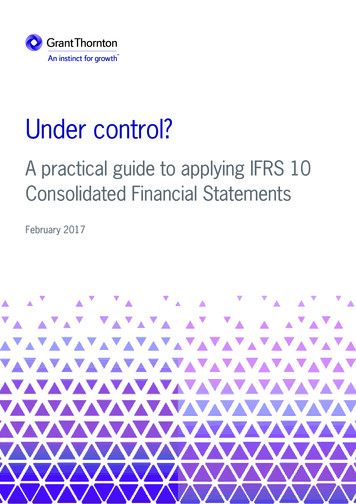
Transcription
A Guide for Father Involvementin Systems of CareTECHNICAL ASSISTANCE PARTNERSHIPfor Child and Family Mental HealthKen MartinezFrank RiderNadia CayceSteve ForssellJeffrey PoirierSharon HuntGerard CrawfordJames SawyerApril 2013
Table of ContentsIntroduction . . . . . . . . . . . . . . . . . . . . . . . . . . . . . . . . . . . . . . . . . . . . . . . . . . . . . . . . . . . . . 1Section I:Where Are the Dads? . . . . . . . . . . . . . . . . . . . . . . . . . . . . . . . . . . . . . . . . . . . . . 3Section II:How Does a Father’s Presence or Absence Affect His Children? . . . . . . . . . . . . . . . 4Section III:Why Is Inclusion of Fathers Important in Systems of Care? . . . . . . . . . . . . . . . . . . .7Section IV:Systems of Care Should Infuse Fathers’ Involvement in All Core Dimensions . . . . . . 9Section V:Fatherhood and Culture . . . . . . . . . . . . . . . . . . . . . . . . . . . . . . . . . . . . . . . . . . . 11Section VI:Young Fathers . . . . . . . . . . . . . . . . . . . . . . . . . . . . . . . . . . . . . . . . . . . . . . . . . . 14Section VII: Grandfathers . . . . . . . . . . . . . . . . . . . . . . . . . . . . . . . . . . . . . . . . . . . . . . . . . . 16Section VIII: Fathers in Families with Child Welfare Involvement . . . . . . . . . . . . . . . . . . . . . . . . 17Section IX:Dads Involved with Substance Abuse . . . . . . . . . . . . . . . . . . . . . . . . . . . . . . . . . 22Section X:Incarcerated Dads . . . . . . . . . . . . . . . . . . . . . . . . . . . . . . . . . . . . . . . . . . . . . . 27Section XI:Dads Who Are Gay and Fathers of Lesbian, Gay, Bisexual, or Transgender (LGBT)Children . . . . . . . . . . . . . . . . . . . . . . . . . . . . . . . . . . . . . . . . . . . . . . . . . . . . . . 32Section XII: Resources . . . . . . . . . . . . . . . . . . . . . . . . . . . . . . . . . . . . . . . . . . . . . . . . . . . . 38Appendix A. . . . . . . . . . . . . . . . . . . . . . . . . . . . . . . . . . . . . . . . . . . . . . . . . . . . . . . . . . . . 44References . . . . . . . . . . . . . . . . . . . . . . . . . . . . . . . . . . . . . . . . . . . . . . . . . . . . . . . . . . . . 45Recommended Citation:Martinez, K., Rider, F., Cayce, N., Forssell, S., Poirier, J., Hunt, S., Crawford, G., Sawyer, J. (2013).A guide for father involvement in systems of care. Washington, DC: Technical AssistancePartnership for Child and Family Mental Health. Available at: php?id topic1#content1
Introduction“Of all the rocks upon which we build our lives, we are reminded today that family isthe most important. And we are called to recognize and honor how critical every father is tothat foundation. They are teachers and coaches. They are mentors and role models. They areexamples of success and the men who constantly push us toward it.”— Barack Obama,1 Father’s Day Speech, Chicago, Illinois, June 15, 2008Fathers are important. Over the course of time, we have learned more about the essentialroles of both mothers and fathers in the healthy development of their children. Contemporarystudies consistently show that children with involved, loving fathers are much more likely to dowell in school; have healthy self-esteem; exhibit empathy and pro-social behavior; and avoidhigh-risk behaviors such as drug use, truancy, and delinquent activity, than children who haveuninvolved fathers (Horn & Sylvester, 2002, p. 15).Often, however, child-serving systems seem to discount the importance of fathers’involvement. They often seem to treat payment of child support as the fathers’ only criticalresponsibility to their children. Financial support is important, but data show that outcomesfor children will improve not by virtue of financial support alone, but also through high-qualityinteractions between fathers and their children. Despite popular opinion, most non-custodialfathers do pay child support; and when they do not, most often it is due to an inability—not anunwillingness—to pay (U.S. Census Bureau, 2006; U.S. General Accounting Office, 1992).In the behavioral health field, sometimes we assume that fathers (and especially fathers ofcolor) don’t care when they are not present at their children’s appointments. As a group,fathers are less likely to attend meetings than mothers. A father who is absent from anappointment, however, is often assumed to be an “absent father,” while similar judgment israrely expressed about a mother in the same circumstance. In fact, most fathers are notabsent fathers. Both systemic and historical factors help us to understand why fathers maysometimes be—or appear to be—less involved in the lives of their children than mothers are.This guide shares information about the importance of fathers in the lives of their children,and it identifies potential consequences if they are not involved. It also offers strategies forsystems and families, especially those who are involved in systems of care, to help fathersbecome more involved. Section I discusses statistics about the presence and absence offathers in families. Section II describes effects of fathers’ absence or presence in the lives oftheir children, and explains why children need an active father in their lives. Section IIIoutlines ways in which systems of care can best support the involvement of fathers inindividual and family service plans. Section IV explains how systems of care can involvefathers in all core dimensions of development (including family-driven, youth-guided services/supports, cultural and linguistic competence, clinical services and structure, governance,social marketing, evaluation, logic model development, strategic planning, the technicalassistance plan, and continuous quality improvement). Section V discusses three different1Then-candidate Barack Obama’s full 24-minute address can be viewed at http://www.youtube.com/watch?v Hj1hCDjwG6MA GUIDE FOR FATHER INVOLVEMENT IN SYSTEMS OF CARE 1
cultural perspectives of fatherhood. Section VI focuses on the important role of young fathersin the growth and development of their children. Section VII, recognizing the increasing numberof grandparents raising grandchildren, considers how best to involve grandfathers; andSection VIII explores the important role of fathers in the child welfare system. The Guideconcludes in Section IX with a collection of national, state, and other resources, gathered tohelp readers learn more about the critical role of fathers in the lives of their children.Authors’ Note: The Technical Assistance Partnership for Child and Family Mental Health’s (TAPartnership) “A Guide for Father Involvement in Systems of Care” is a work in progress. Sincelaunching our Fatherhood Learning Community in 2009, we have been continuously impressed bythe commitment of communities around the country to enhance efforts to apply the gifts of fathersand male caregivers to the development and improvement of their systems of care. We would like toacknowledge the contributions of our community partners to this Guide, including Robert Clanagan,LaRone Greer, Kurt Moore, Esteban Zubia, John Cruz and the New Jersey Alliance of Family SupportOrganizations. The TA Partnership welcomes your suggestions in continuing to build this body ofexpertise. For more information, please contact Ken Martinez, Psy.D., at kmartinez@air.org.A GUIDE FOR FATHER INVOLVEMENT IN SYSTEMS OF CARE 2
SECTION I: Where Are the Dads?Fathers who live with their children are more likely to have close,enduring relationships with their children than those who do not.For many decades, however, the stability of family relationshipswithin which children are raised has significantly eroded. Thefollowing statistics from the National Fatherhood Initiative’s FatherFacts (Horn and Sylvester, 2002) sketch a profile of the changingdemographics of American families in which today’s children aredeveloping:yy Forty-three percent of first marriages dissolve within 15 years, and approximately 60percent of divorcing couples have children. Roughly one million children each yearexperience the divorces of their parents.yy Nearly 20 million American children (27 percent) live in single-parent homes. Eighteenpercent of the single parents who currently live with their children are men, while 82 percentare women. (Of the single parents who are fathers, 8 percent are raising three or morechildren under 18 years of age.)yy The number of single fathers in the U.S.—now 2.5 million—has increased more thansix-fold from 400,000 in 1970. Forty-two percent of single fathers are divorced, 38 percent have never married, 16percent are separated, and 4 percent are widowed; and Seventy-three percent have an annual family income of 50,000 or less.yy Compared to children born to married parents, children born to cohabiting parents are threetimes as likely to experience eventual father absence; and children born to unmarried,non-cohabiting parents are four times as likely to live in a father-absent home.yy From 1995 to 2000, the proportion of children living in single-parent homes slightlydeclined, while the proportion of children living with two married parents remained stable.yy Still, 24 million children (34 percent) today do not live with their biological fathers. Approximately 26 percent of absent fathers live in a different state than their children. Approximately 40 percent of children in father-absent homes have not seen their fatherseven once during the past year; and Approximately 50 percent of children not living with their fathers have never set foot intheir fathers’ homes.“It is easier for a father to have children than for children to have a real father.A GUIDE FOR FATHER INVOLVEMENT IN SYSTEMS OF CARE”— Pope John XXIII 3
SECTION II: How Does a Father’s Presence orAbsence Affect His Children?The presence and active involvement of a father makes hischildren more likely to do well in school, have healthy self-esteem,exhibit pro-social behavior, and avoid high-risk behaviors,compared with children who are raised without a father(reference).Conversely, boys and young men growing up without a father faceenormous risks compared with males who are raised with theirfathers. The below statistics from the Urban Leadership Institute’sDare To Be King curriculum (2006) document those risks for children and youth.Children/Youthfrom Fatherless HomesChildren/Youthfrom Homes with Fathers63 percent of youth suicides37 percent of youth suicides90 percent of homeless and runaway youth10 percent of homeless and runaway youth85 percent of youth who exhibit behavioraldisorders15 percent of youth who exhibit behavioraldisorders71 percent of all high school dropouts29 percent of all high school dropouts75 percent of all youth in chemical abusecenters25 percent of all youth in chemical abusecenters70 percent of youth in state-operatedinstitutions30 percent of youth in state-operatedinstitutionsWhat accounts for these differences between fatherless homes and homes with fathers?Dr. Stephen D. Green’s research focused on the dynamics between fathers and their children,and provides some insight through these “20 reasons why a child needs an active father inher/his life” (Green, 2000):20 Reasons Why Your Child Needs You to be an Active Father1.Lets a child know that he/she is loved. Love involves more than saying the words “Ilove you.” Fathers who love their children demonstrate their love by spending quality andquantity time with their children. Children who feel loved are more likely to developstrong emotional bonds with their fathers and develop healthy self-esteem.2.Provides a child with greater financial resources. Research indicates that families withan active father are “better off” financially. This means that children with active fathersare more likely to have access to resources that facilitate healthy development (e.g.,food, clothing, shelter, quality medical care).A GUIDE FOR FATHER INVOLVEMENT IN SYSTEMS OF CARE 4
20 Reasons Why Your Child Needs You to be an Active Father (continued)3.Provides a child with a positive male role model. Children, regardless of gender, needpositive male and female role models. Children tend to model behavior (positive andnegative) that they witness on a consistent basis. Active fathers can promote positivebehaviors by setting a proper example for their children.4.Provides a child with emotional support. In addition to financial support, children alsoneed emotional support from their parents. Active fathers listen and support theirchildren when they experience joy, sadness, anger, fear, and frustration. Fathers whosupport their children emotionally tend to raise children who are more in tune with theneeds of others.5.Enhances a child’s self-esteem. Self-esteem refers to how a person feels abouthimself. Children with high self-esteem tend to be happier and more confident thanchildren with low self-esteem. Active fathers promote their children’s self-esteem bybeing fully involved in their lives and letting them know that they are highly valued.6.Enhances a child’s intellectual development. Children who are raised with activelyinvolved fathers tend to score higher on measures of verbal and mathematical abilityand also demonstrate greater problem-solving and social skills.7.Provides a child with guidance and discipline. From infancy, children need properguidance and discipline. Active fathers play an important role in teaching their childrenproper behavior by setting and enforcing healthy limits.8.Gives a child someone to play with. One of the primary ways that fathers bond withtheir children is through play. According to researchers, there are differences in the waysfathers and mothers play with their children. Fathers tend to use a more physical styleof play (e.g., wrestling) that offers a number of benefits to children, including enhancedcognitive ability.9.Provides a child with someone to talk to when he/she has questions. Young childrenare full of questions. This natural curiosity helps them learn about their environment.Active fathers can be a valuable source of information for children who are seekinganswers to life’s important questions.10. Increases a child’s chances for academic success. Children whose fathers are activelyinvolved in their lives are more likely to achieve academic success than children whosefathers are not actively involved. These academic benefits appear to extend intoadulthood.11. Provides a child with an alternative perspective on life. Research indicates that menand women often differ in their parenting styles; however, one style is not necessarilybetter than the other. Instead, it can be healthy for children to be exposed to differentperspectives on life, such as a father’s.A GUIDE FOR FATHER INVOLVEMENT IN SYSTEMS OF CARE 5
20 Reasons Why Your Child Needs You to be an Active Father (continued)12. Lowers a child’s chances for early sexual activity. Children with actively involvedfathers are less likely to engage in early sexual activity, thus reducing their chances forteen pregnancy and sexually transmitted diseases.13. Lowers a child’s chances for school failure. Children with actively involved fathers areless likely to drop out of school than children with uninvolved fathers.14. Lowers a child’s chances for youth suicide. Children with actively involved fathers areless likely to commit suicide than children with uninvolved fathers.15. Lowers a child’s chances for juvenile delinquency. The benefits of having an activefather throughout a child’s early years extend into the teen years as well. Children withactive fathers are less likely to commit juvenile crimes than children with inactivefathers.16. Lowers a child’s chances for adult criminality. The chances that a child will commitcrimes as an adult also diminish when he grows up with an actively involved father.17. Provides a child with a sense of physical and emotional security. One of the majorbenefits that fathers can provide to their children by being actively involved is a sense ofsecurity (physical and emotional). By being actively involved in a child’s life, a fatherpromotes a trusting relationship. The child does not have to worry about beingabandoned.18. Facilitates a child’s moral development. Children need a moral compass to guide themwhen they face difficult moral choices. Fathers, like mothers, help children to develop asense of right and wrong that serves as a foundation for establishing moral character.19. Promotes a healthy gender identity in a child. Boys and girls benefit from havinghealthy role models from both sexes. Research points to the fact that mothers andfathers socialize their children in different ways. Fathers can help their children,especially boys, to develop a healthy sense of what it means to be a male.20. Helps a child learn important life skills. Most of the essential life skills that childrenneed to survive are learned within the home. Fathers have a unique opportunity to teachtheir children valuable skills that will enable them to grow up to be healthy andproductive adults.From 20 Reasons Why Your Child Needs You to Be an Active Father, by S. D. Green (2000).A GUIDE FOR FATHER INVOLVEMENT IN SYSTEMS OF CARE 6
SECTION III: Why Is Inclusion of Fathers Important inSystems of Care?Fathers are an integral part of their families and communities. Theyare part of the solutions needed to address challenges. Whilesometimes not valued as much as they deserve to be, fathers bringa rich perspective to systems that have historically focused primarilyon mothers or female caregivers.When fathers are involved in their children’s lives, the children theycare for enter formal systems less frequently, less deeply, and forshorter periods of time. Because the majority of enrolled children insystems of care are male, inclusion of male caregivers in systems of care is especiallycritical. Building systems of care is hard work, and we need everyone involved.How Can Systems of Care Best Support the Involvement of Fathers in Individualand Family Service Plans?Over time, system of care communities have learned and shared successful strategies aboutworking with fathers and male caregivers. Strategies have been identified at both theindividual (child, family) level, as well as at the system level. (System-level strategies will bedescribed in Section IV.)The Individual Planning Team Should yy Ensure that fathers have access, voice, and choice in the development, implementation,and revision of service plans.yy Make a conscious effort to recognize and understand the cultural implications of being amale caregiver.yy Be in the habit of asking caregivers, “Will Dad be a part of the meeting?” When settingappointments, ask the mother, “Can Dad be sent an invitation if he is not part of thehousehold?”yy Make efforts to understand fathers’ work schedules, and try to schedule meetings at timesthat are convenient for fathers.yy Ensure that professionals speak with and to fathers (eye-to-eye contact)—not about or overthem in ways that can serve to exclude and eventually alienate them.yy Engage Dad by asking for his opinion/insight if he is not saying anything during a meeting.yy Seek fathers’ input/ideas/concerns in advance of meetings they are unable to attend.yy Follow up with fathers when they must be absent from meetings (e.g. due to work,immigration, military service, incarceration status, etc.) to ensure they understand what hasbeen discussed; to elicit their input, feedback, and suggestions; and to incorporate theirideas into their children’s plans. Work with the custodial mother or legal guardian to includethe father even when he is not the custodial parent or legal guardian, within the parametersthe court sets forth during the process of divorce and after the divorce is final.A GUIDE FOR FATHER INVOLVEMENT IN SYSTEMS OF CARE 7
yy Ensure that service plans are culturally and linguistically competent. They should meet thediverse needs of fathers by ensuring that cultural preferences, practices, and mores arelearned, understood, and honored.yy Make every effort to discover fathers’ strengths, needs, and key cultural considerations thatare relevant to addressing the needs of their children in order to develop truly effectiveindividualized plans.“My father didn’t tell me how to live; he lived, and let me watch him do it.A GUIDE FOR FATHER INVOLVEMENT IN SYSTEMS OF CARE”— Clarence B. Kelland 8
SECTION IV: Systems of Care Should Infuse Fathers’Involvement in All Core DimensionsEarnest efforts in dozens of communities are aiming to attract andoptimize the many valuable contributions that fathers can bring tothe development and refinement of systems of care in which theirchildren with mental health and related challenges can succeedand thrive. During the past two years the authors’ conversationswith many at the forefront of those community efforts have yieldeda lengthy list of suggestions and recommendations about infusingfather’s involvement. We hope many of these strategies can helpyour community to attract the positive “power of dads” to keydimensions of system development and implementation including family-driven, youth-guidedservices/supports, cultural and linguistic competence, clinical services and structure,governance, social marketing, evaluation, logic model development, strategic planning, thetechnical assistance plan, and continuous quality improvement.ORGANIZATIONALyy Ensure that you hire those who embrace the power of positive contributions andparticipation by fathers when recruiting individuals for influential and decision-makingpositions within your system of care or organization.yy Understand and respect men in our society. Provide training to staff on the “culture offathers” (innate characteristics and socialization of men), which is different from the cultureof mothers.yy Link with local, state, and national fatherhood initiatives to share information and developpartnerships that are mutually beneficial.yy Find out what fathers need and want to be actively involved in the lives of their children thatmay be particular to your specific population of focus, system of care, cultural group,geographic region, and community; make accommodations to meet their needs and requests.yy Create father-friendly programs that focus specifically on fathers. Make sure initiatives arewelcoming and engaging to males.yy Ensure that all forms (registration, intake, evaluation) used for interviews, screenings,clinical assessments and evaluations, service and supports, system evaluation(methodology, data fields chosen, analysis of data), surveys, and literature speak about andinclude fathers in the information and interventions.OUTREACH AND ENGAGEMENTyy Be creative with outreach and recruitment efforts. Go where the fathers are (e.g., housesof worship, barbershops, cultural gatherings). Recognize that male-to-male outreach,engagement, and partnering is critical for success.yy Individualize outreach to, and engagement with, fathers (effective methods often differ fromthose for mothers), using methods that appeal to fathers, including gay, bisexual, transgenderand questioning fathers, and provide opportunities that involve more doing than talking.A GUIDE FOR FATHER INVOLVEMENT IN SYSTEMS OF CARE 9
yy Provide leadership in engagement from within the system of care, by actively seeking outfathers of the children involved in the system(s) through individual phone calls, home visits,and face-to-face relationship building.yy Focus outreach and other social marketing efforts on reaching fathers in ways that areinviting and non-judgmental, and that promote their unique world view and focus on destigmatizing their involvement.yy Send Dad invitations to meetings/activities if he is not in the household.yy Acknowledge and respect fathers’ input, perspectives, and communication styles, althoughthese may be different from mothers’. Fathers have feelings.PROGRAMMING AND TRAININGyy Focus on action so men don’t feel threatened by having to talk about their concerns,especially at the beginning. Males typically prioritize fixing problems over talking about them.yy Develop father- and child-centered activities, such as sporting activities, camping, videogames, etc.yy Arrange opportunities for fathers to lead projects for which they can recruit other males.yy Collaborate with other existing community activities that focus on fathers, so that fatherscan become, or can remain, connected to their own communities and influence the directionand focus of other programs to be father friendly.yy Provide training focused on the social-emotional development of children, on practicalparenting skills, and on the essential contributions of fathers to their children’sdevelopment. This training is as important for mothers as for fathers.yy Develop and provide training/coaching/mentoring geared specifically for fathers, by fathers,including unique populations such as teen fathers or fathers who are gay, bisexual,transgender, or questioning. Identify/create opportunities to encourage fathers’ mentoringof children.yy Ensure the inclusion and participation of fathers in family support groups and familyleadership teams.yy Look for father groups/organizations that fathers in your community can be directed to thatmay help them with their needs as males and/or dads, whether your site has a fathers’group or not.yy Make purposeful efforts to retain and challenge fathers and male caregivers in positiveways. Retention is imperative!yy Ensure that children of gay, bisexual, and transgender individuals and individualsquestioning their sexual identity know that they and their families are supported. They arefathers, too. Sexual identity is not determined by whether one fathers a child. This is anespecially vulnerable population that may be forcibly alienated from their children. Createenvironments that are welcoming and inclusive.yy Always let fathers know that they are not alone; that they are valued; that they will besupported through various means, including peer mentoring, support groups, andspecialized or focused training; and that they will always be treated with respect.A GUIDE FOR FATHER INVOLVEMENT IN SYSTEMS OF CARE 10
SECTION V: Fatherhood and CultureWhile “ethnic families and fathers do not deviate much fromAnglo-American families and fathers, they still should not be judgedby white middle-class standards. Ethnic minority families arediverse, and there is no single monolithic ethnic family structureamong or within them. Internal variation within major ethnic groupsprohibits generalization” (Fatherhood, 2003).New generations of fathers, including those from different ethnic/racial groups, are engaging in a “new fathering” paradigm thattakes the best from what they were taught and combines it with what they strive to be asfathers, so that they develop a style that is comfortable and “generative” for their childrenand future generations.“”Fatherhood is pretending the present you love most is “soap-on-a-rope.— Bill CosbyHISPANIC/LATINO FATHERHOODHispanic/Latino men, as with other men of color, are frequently and incorrectly stereotyped.They are portrayed as being authoritarian, distant, not emotionally connected, averse to familyintimacy, and machista husbands and fathers. Contrary to popular myth, Hispanic/Latinofathers do not conform to stereotypes or media portrayals. There is growing evidence thatdeficit models to describe fathers of color do not accurately describe the care they feel andshow for their children (Fitzpatrick et al., 1999; Toth & Xu, 1999).A recent study (Taylor & Behnke, 2005) found that “a transformation is taking place amongLatino fathers on both sides of the border. Many fathers exhibit contemporary views andfeelings that reflect the trend of ‘new fathering.’ They are redefining machismo through theirattitudes and fathering practices. Although many fathers on both sides of the border areinvolved and aware of their children’s needs and aspirations, to those on the outside thesefathers may still show signs of traditionality.” The report notes that the Latino men in thisstudy were “profoundly affected by their relationships with their fathers, who ranged frominvolved dads to absent dads.” This is similar to other findings that fathers’ own fathers’models of parenting, whether positive or negative, influenced how they interacted with theirchildren (Daly, 1995).Taylor and Behnke also state that the most prominent value that Latino fathers want totransmit to the next generation is the importance of a good education; they also want to instilla strong work ethic in their children. The fathers want to see their children in better jobs but,at the same time, don’t want them to lose the satisfaction of working hard. The authorsconclude that their findings support the idea of “generative fathering” (meeting the needs ofthe next generation instead of current societal expectations [Hawkins & Dollahite, 1997]) todescribe the resiliency of Latino fathers and the contributions they make to families,communities, and future generations.A GUIDE FOR FATHER INVOLVEMENT IN SYSTEMS OF CARE 11
Although many Latino fathers are significantly affected by poverty and economic hardship, theyhave strong family values and belong to tight-knit communities that increase their resiliency(Vega et al., 1986). Latino fathers are complex individuals with family values that facilitatetheir involvement in the lives of their families (Coltrane, Parke, & Adams, 2004). Thesestudies seem to indicate that Hispanic/Latino fathers defy the stereotypes ascribed to themand instead define their own style of parenting that combines the best of what they learnedfrom their fathers and their own styles of what they think is right.AFRICAN-AMERICAN FATHERHOODAfrican-American fathers are often characterized as absent, violent, and uninvolved in theirchildren’s lives. “Policy discussions, while they do not always identify
(reference). Conversely, boys and young men growing up without a father face enormous risks compared with males who are raised with their fathers. The below statistics from the Urban Leadership Institute’s Dare To Be King curriculum (2006) document those risks for children and y










